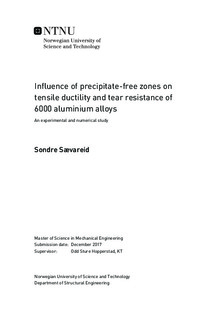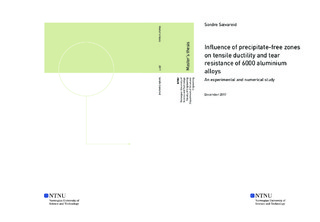| dc.description.abstract | The influence of the precipitate free zones (PFZs) on ductility of aluminium alloys of the 6xxx- series was investigated. Precipitate free zones are zones along the grain boundary with no precipitates, resulting in a softer zone compared to the grain interior. The width of these zones can vary and can be changed using different quenching rates. How the PFZs affect the mechanical properties of the 6xxx-series is not fully examined and was the main topic of this thesis. Three 6xxx-series alloys were investigated: AA6060, AA6082.25 and AA6082.50. How the PFZs influence the ductility was investigated by using two different quenching rates after solution heat-treatment: air-cooling and water-quenching at room temperature. This was done to achieve two different PFZ-widths, where the air-cooling would result in the widest PFZ. It was expected that a wider PFZ resulted in a less ductile material. The experiments were conducted using three tests: the round smooth tensile test, the round v-notch tensile test, and the Kahn tear test. The results were then compared both experimentally and numerically.
The smooth tensile test and the v-notch tensile test were used for material calibration. Central mechanical properties from the Kahn tear test were obtained and used to compare the air-cooled and water-quenched test specimens. One of these properties was the unit propagation energy (UPE) and is a measure of the material's ability to withstand crack growth. This was used to investigate the ductility of the different materials. The air-cooled specimens all had wider PFZs compared to their water-quenched counterparts, which was expected. However, this did not result in a significant reduced ductility of the air-cooled test specimens. In three out of six cases, the UPE for the air-cooled specimens was larger compared to their water-quenched counterparts. In the cases where the water-quenched specimens had higher UPEs, it was due to an increased maximum force. The PFZ-width appeared not to have a large influence on tear resistance for the quenching rates used.
A numerical study was performed in which all tests were simulated using the Gurson-Tvergaard-Needleman (GTN) model. The fracture model was calibrated by only varying the initial void volume fraction. The GTN-model accounts for damage and failure by void nucleation, growth and coalescence only and the model gave good results where this fracture mode was dominant. Some of the materials had a significant presence of fracture along the grain boundaries. For these materials, the resulting forces in the simulations were overestimated, indicating that the presence of fracture along the grain boundaries happens with less resistance.
A wider PFZ resulted in an increase of intergranular fracture. However, this increase did not affect the ductility in terms of the UPE. The difference in strength between the grain interior and PFZ was probably more important than the width of the PFZ. The air-cooled specimens had a significant lower strength compared to their water-quenched counterparts and resulted in material with higher ductility. | en |

